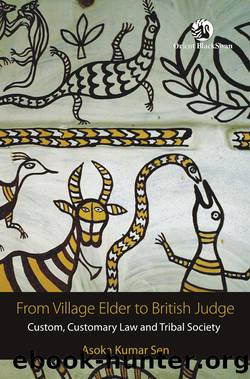From Village Elder to British Judge: Custom, Customary Law and Tribal Society by Asoka Kumar Sen

Author:Asoka Kumar Sen
Language: eng
Format: azw3
Tags: From Village Elder to British Judge
Publisher: Orient Blackswan
Published: 2012-10-19T00:00:00+00:00
Significantly, the KS and DC shared the power of appointment. The Kolhan Deputy Collector (KDC) was absolved of his responsibility, though DC could still transfer his jurisdiction to him as per court practice. Moreover, the order removed the lacunae of an earlier order by making it necessary for the observance of hereditary and familial norms in usual cases and social selection by the villagers and Manki, when a Munda was issueless. But the order failed to be comprehensive in the appointment of the Manki. Though the hereditary and familial norm was not overtly disputed, the procedure of selection in the case of either the termination of family line or dismissal was not stated. So this order did not emerge as a foolproof guide.
The Kolhan administration also sought to introduce an innovative age138 criterion in the appointments of village and pir heads. A court order issued by J. E. Scott in 1920 read: âIf a Munda or Manki die leaving a minor son of 8 or upwards, the minor should be made a Munda and an acting Munda appointed. If the heir to dead Munda or Manki is a child under 8 years i.e., if it will be more than 10 years before he can act, he should not be made Munda. The acting appointment will be made & the confirmation will depend on character and ability of acting man & minor when latter is old enough to be himself Munda or Manki.â139
The order meant that at the age of eight, a Munda/Mankiâs son might ordinarily be appointed to his fatherâs post, but an acting Munda/Manki would act on his behalf. The incumbent would become a functioning official when he reached eighteen, confirmation of which however would depend on his character and ability.
Transfer of land through sale or mortgage
Both jurisprudential and political intent were behind overseeing the process of sale and mortgage to prevent indiscriminate land transfer. Land became the most valued item of property ever since adivasis of Jharkhand region adopted settled cultivation around permanent villages. Its significance grew further when their free expansion over forest tracts was curtailed by the Forest Acts. Territorial control figured as the principal issue during tribal agitations mentioned above in Chotanagpur and Santal Parganas. Unnerved colonial rulers passed SPT Act and the CNT Act to stop land alienations. Even then, tribal lands continued to pass to individuals, particularly moneylenders, and corporate groups.140 Administrators took recourse both to the Land Acquisition Act, 1894, and clause 50 of the CNT Act to acquire tribal lands for mining and other purposes. Though tribal regions did not witness the recurrence of a major tribal uprising after the Birsite Ulgulan, discontent was simmering within as manifested by milder social protests. The adivasis of Singhbhum showed different forms of resistance against official attempts to bring their lands under rent and restrict their customary rights to extend cultivation in the forested regions.141 This awakened British officials to the fact that land had not only survivalist significance for an indigene, but it was also an identity marker.
Download
This site does not store any files on its server. We only index and link to content provided by other sites. Please contact the content providers to delete copyright contents if any and email us, we'll remove relevant links or contents immediately.
The Thirst by Nesbo Jo(5784)
Permanent Record by Edward Snowden(4996)
The Myth of the Strong Leader by Archie Brown(4789)
Spare by Prince Harry The Duke of Sussex(4195)
A Higher Loyalty: Truth, Lies, and Leadership by James Comey(4032)
Secrecy World by Jake Bernstein(3782)
Adulting by Kelly Williams Brown(3668)
The Borden Murders by Sarah Miller(3590)
Fear by Bob Woodward(3260)
Killers of the Flower Moon by David Grann(3235)
The Last Girl by Nadia Murad(3054)
The Secret Barrister by The Secret Barrister(3008)
Future Crimes by Marc Goodman(3002)
American Kingpin by Nick Bilton(2970)
Liar's Poker by Michael Lewis(2810)
The House on Mango Street by Sandra Cisneros(2777)
Graduate Admissions Essays, Fourth Edition: Write Your Way into the Graduate School of Your Choice (Graduate Admissions Essays: Write Your Way Into the) by Asher Donald(2474)
Delicious Torment by Linsey Lanier(2447)
Camino Island by John Grisham(2383)
